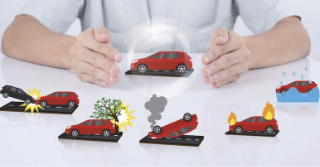That’s why almost every state requires motorists to have insurance for their vehicles. The minimum amount of insurance you need varies by state, but most states require you at least carry liability insurance. In most cases, though, you don’t want to settle for the minimum amount of required insurance.
Your auto policy must protect you and other people on the road. On top of these must-haves, you should consider adding a few other types of coverage that can really save you money in the event of an accident.
Must-haves for auto insurance
Three types of auto insurance exist that you always want to have. You may even be required to have these types of coverage in your state. Required or not, these insurance types help protect you from extremely high damage expenses in the event of an accident.
1. Liability insurance
Liability insurance comes in two forms: bodily injury liability and property damage liability. Bodily injury liability pays for injuries to other drivers and their passengers if you are at fault in an accident. Property damage liability pays for damage to other vehicles.
Most states require some form of liability insurance at a minimum, but these minimum levels often don’t cover actual bodily injury or property damage costs, forcing drivers at fault to pay for additional damages out of pocket. Because of this, it’s a good idea to opt for a higher-paying policy if you can afford it.
2. Personal injury protection (PIP)
PIP is not required or offered in every state but, where applicable, it pays for your and your passengers’ medical expenses, regardless of whether you are at fault in an accident.
3. Uninsured or underinsured motorist coverage
If you get into a car accident and are not at fault but the other driver is not insured or is underinsured, you could be left paying for damages yourself. With uninsured or underinsured motorist coverage, you are covered if the other driver is not. Some policies may cover both bodily injury and property damage.
Should-haves for auto insurance
When you have liability insurance and the other required forms of coverage on your auto insurance policy, you’re not required to purchase more coverage. However, you should realize that this could leave you open to potentially high costs for personal bodily injury and vehicle damage. By adding on these three types of auto insurance coverage, you’ll be covered in almost every possible situation.
1. Collision insurance
Collision insurance helps pay for the damage to your vehicle if you caused the accident. This type of insurance is an especially good idea if you have a newer car that would be expensive to replace.
2. Comprehensive insurance
Comprehensive auto insurance pays for damage to your car by severe weather or fire. It also pays if someone were to break into or steal your vehicle. Consider this insurance if you have a newer car or live in an area with a history of car theft.
3. Medical payments
Medical payment coverage is not always necessary if you have good health or personal injury insurance because those types help pay for your own bodily injuries in a crash. However, this type of coverage is a smart choice if your existing policies cover only a certain amount or percentage of your or your passengers’ medical bills in a collision.
It’s better to be prepared
You never expect to get into a car accident but, if it happens, you’ll be thankful your insurance policy helps reduce — or completely covers — the amount you’ll owe in medical expenses or other damages. With high risks, it’s much better to be prepared. That’s why getting the right type and amount of auto insurance is so important.



